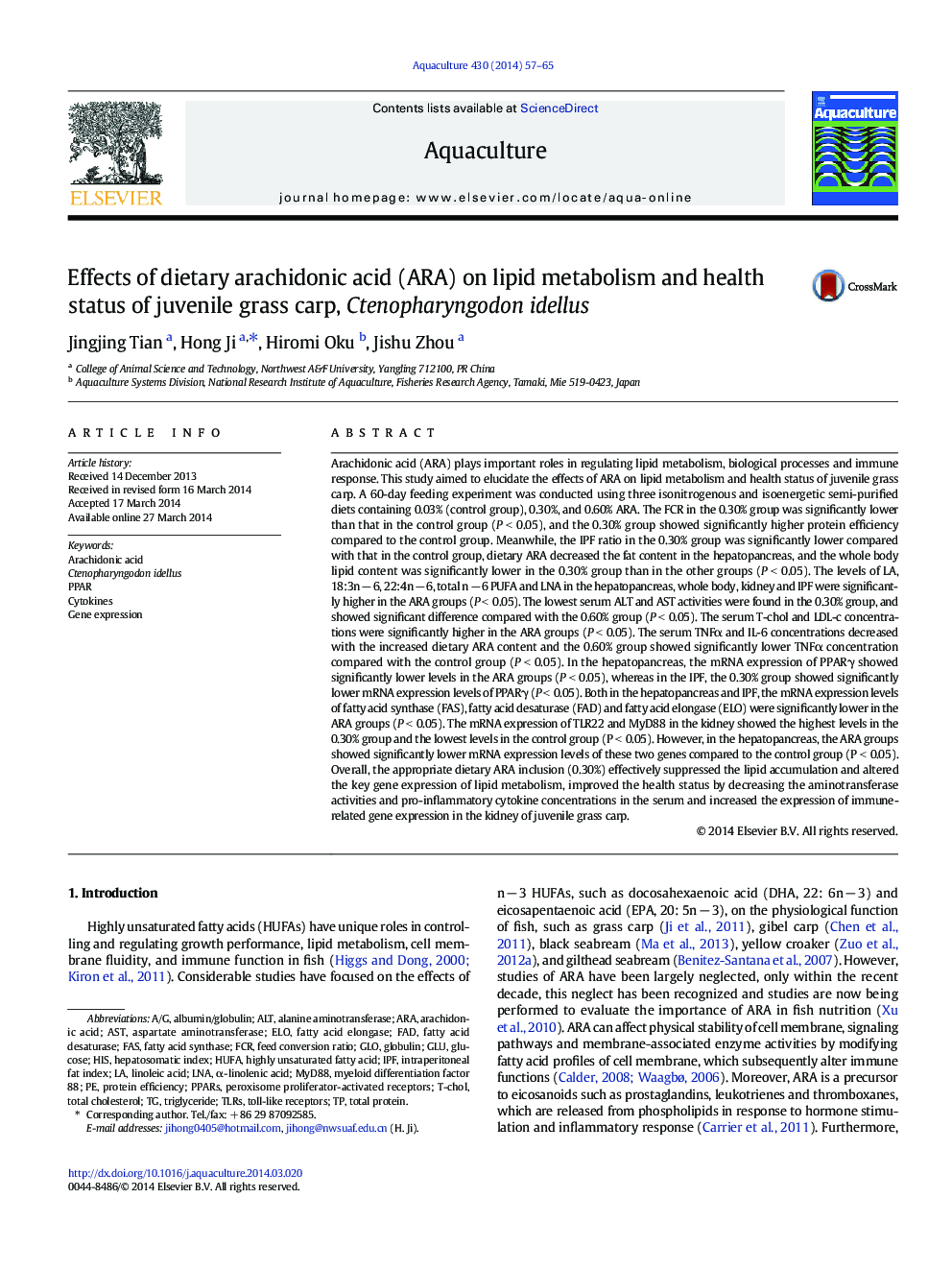| کد مقاله | کد نشریه | سال انتشار | مقاله انگلیسی | نسخه تمام متن |
|---|---|---|---|---|
| 2421832 | 1552857 | 2014 | 9 صفحه PDF | دانلود رایگان |

• Dietary ARA improved feed efficiency in grass carp.
• Dietary ARA inhibited fat accumulation as well as PPARγ and FAS gene expression.
• Dietary ARA modified tissue FA profiles, inhibited FAD and ELO gene expression.
• Dietary ARA decreased TNFα, IL-6 and aminotransferase release.
• Dietary ARA increased TLR22 and MyD88 gene expression in the kidney.
Arachidonic acid (ARA) plays important roles in regulating lipid metabolism, biological processes and immune response. This study aimed to elucidate the effects of ARA on lipid metabolism and health status of juvenile grass carp. A 60-day feeding experiment was conducted using three isonitrogenous and isoenergetic semi-purified diets containing 0.03% (control group), 0.30%, and 0.60% ARA. The FCR in the 0.30% group was significantly lower than that in the control group (P < 0.05), and the 0.30% group showed significantly higher protein efficiency compared to the control group. Meanwhile, the IPF ratio in the 0.30% group was significantly lower compared with that in the control group, dietary ARA decreased the fat content in the hepatopancreas, and the whole body lipid content was significantly lower in the 0.30% group than in the other groups (P < 0.05). The levels of LA, 18:3n − 6, 22:4n − 6, total n − 6 PUFA and LNA in the hepatopancreas, whole body, kidney and IPF were significantly higher in the ARA groups (P < 0.05). The lowest serum ALT and AST activities were found in the 0.30% group, and showed significant difference compared with the 0.60% group (P < 0.05). The serum T-chol and LDL-c concentrations were significantly higher in the ARA groups (P < 0.05). The serum TNFα and IL-6 concentrations decreased with the increased dietary ARA content and the 0.60% group showed significantly lower TNFα concentration compared with the control group (P < 0.05). In the hepatopancreas, the mRNA expression of PPARγ showed significantly lower levels in the ARA groups (P < 0.05), whereas in the IPF, the 0.30% group showed significantly lower mRNA expression levels of PPARγ (P < 0.05). Both in the hepatopancreas and IPF, the mRNA expression levels of fatty acid synthase (FAS), fatty acid desaturase (FAD) and fatty acid elongase (ELO) were significantly lower in the ARA groups (P < 0.05). The mRNA expression of TLR22 and MyD88 in the kidney showed the highest levels in the 0.30% group and the lowest levels in the control group (P < 0.05). However, in the hepatopancreas, the ARA groups showed significantly lower mRNA expression levels of these two genes compared to the control group (P < 0.05). Overall, the appropriate dietary ARA inclusion (0.30%) effectively suppressed the lipid accumulation and altered the key gene expression of lipid metabolism, improved the health status by decreasing the aminotransferase activities and pro-inflammatory cytokine concentrations in the serum and increased the expression of immune-related gene expression in the kidney of juvenile grass carp.
Journal: Aquaculture - Volume 430, 20 June 2014, Pages 57–65